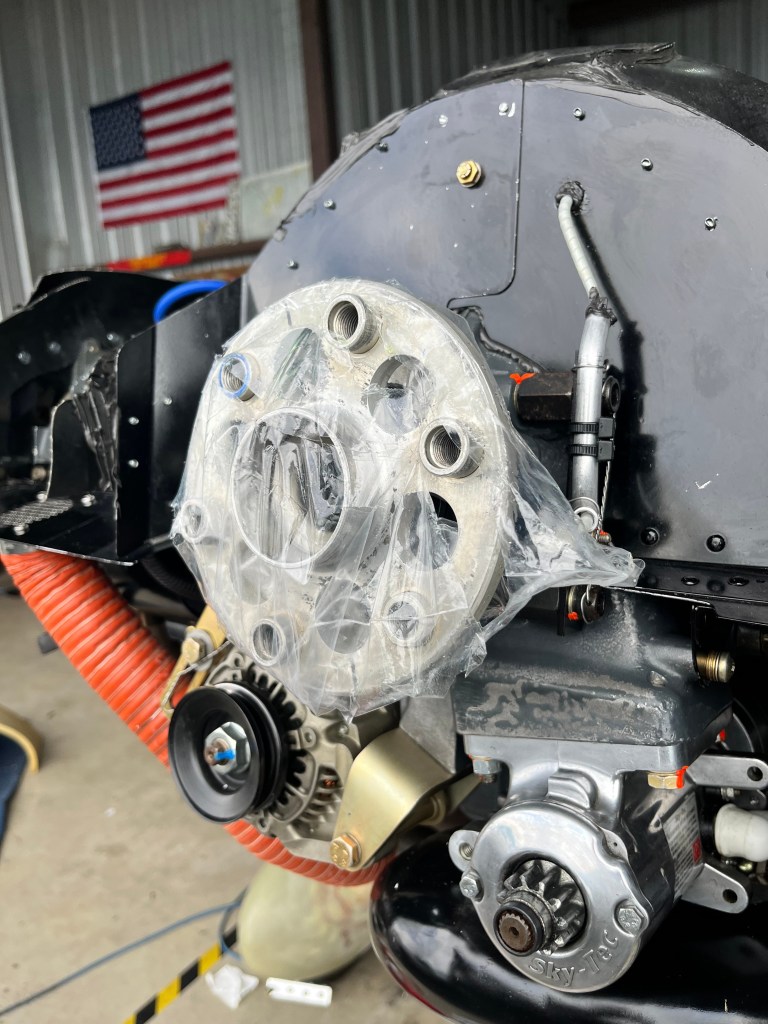I’ve completed 7.3 hours now in N22UP since June 13th. And during that time there has been a number of maintenance issues dealt with, and general tweaks. We’ll try to hit them one by one.
After the first flight it was readily apparent that I had three noticeable issues. First, there was an oil leak off the accessory case. Exactly where, was hard to tell – as the oil goes everywhere. I wrapped a bit of paper towel around a couple suspect areas, and determined it was likely the o-ring on the prop gov oil line. Additionally, the nose seal was weeping some oil, and the horizontal induction snorkel was rubbing the cowl. None were going to cause me to fall out of the sky, but all would be dealt with. After a couple more flights, I decided it was time to deal with them immediately to save the alternator etc from getting drenched in oil.
Nose seal.
Here you can see some photos of the mess the nose seal is making spraying oil everywhere.



Replacing the nose seal means pulling the prop and the flywheel. And in my case, it also means the crankshaft timing wheel for the ElectroAir ignition also must be removed… and then retimed.



Here you can see the old nose seal as we’ve gotten it out before we cut it off. After we cut it off it took quite a bit of time to get the old bonding agent cleaned out.

Then the new nose seal goes into hot water, and then is stretched over top using a special tool.

Unfortunately, after returning the airplane to service, the latest flight shows that the nose seal – or something in its immediate vicinity is still leaking. So I’ve ordered a new nose-seal, and we’ll start chasing this down again.
Breather tube.
I don’t have a picture of this at the moment. But basically I relocated the tube further aft for its exit above the exhaust.
Prop Oil Line O-Ring.
Here’s the o-ring fitting in question. A bit of a pain in the butt to reach. After replacing this o-ring,


Here are a few pictures of the old o-ring after removal. It looks like it got mangled in the threads.


After replacing the o-ring, there is still a leak in the vicinity. Using some paper towel testing shows the leak appears to be the oil cooler bypass valve. I have a new gasket for that already enroute.
Induction snorkel rubbing cowl.
When the rubbing was first discovered, I placed some 3M double sided tape in the area to protect the parts temporarily. I cut a section out and fiberglassed in a new section with about 1/4 of relief. 


Unfortunately, that was not enough. As you can see, I now have two new areas that are rubbing. (Little black rubbing points). So, I’ll have to provide even more relief.

My approach to each point is to get a straight edge and mark a circle around each that represents about 1/4 of fall from the high point. You can see this resultant circles here.

I then cut an even larger section out than previously. I glassed over this today, and will get a photo next time I am at the hangar. 
Broken wheel pant.
Turns out I didn’t trim my wheel pant to tire clearance far enough. The tire rubbed the pant enough on the first flight landing that it cracked the wheel pant and took a chunk out. I used some flox to get the cracks and removed chunk back in place. 
Then i used my thicker glass weave on the inside, and my fine weave on the outside. 

Lastly, I trimmed both wheel pants further, and re-installed.
Scat tube rubbing oil dipstick.
The scat tube that runs from the baffle to the oil cooler, was being problematic. It was rubbing the oil dipstick tube, and potentially the engine mount. I tried one fix – shortening the scat tube, but unfortunately I did one trim too many and lost the appropriate amount of flex needed for engine movement. So a new bit of scat was installed. This time, I decided to go dirt simple. Zip-tie plus rubber tubing offset and some silicone tape.


Oil and filter change.
I did an oil change at 6.4 hours. Since I had to pull the prop for the nose seal, I figured I might as well do it. Here you can see my methods using my awesome quick drain.

As well as my form-a-funnel for the oil filter.

I cut open the oil filter.


Mike Rollison showed me a neat trick to remove the oil filter pleats and then squeeze the oil out with a vice. Here are photos of the cleaned up oil filter pleats.


Some small bits of metal were evident. None were ferrous. Mike said this is 100% in line with what he would expect for an engine during break in. I kept the pleats so that they can be compared to the next oil change.

I also sent my oil to Blackstone Labs for oil analysis. Yes, its a bit early, but nows the time where there could be trouble. So lets see what the oil has to say.
New seats and stick boots.
I bought nice stick boots from Oregon Aero. These will protect from foreign objects getting lodged and give the cockpit a good aesthetic. I was also able to grab a set of used Classic Aero cloth seats off Van’s. The trim is blue, which doesn’t work exactly for my plane, but these will do perfectly for now. They even came with extra material and booster seats!


Brake line length reduction.
I forgot to take any before photos, but basically the low pressure brake oil lines were too long. They needed about 4″ per side removed. I also needed to then add some new protections against rubbing in place. Here is the result.

Also, a bonus photo of Squire. Because he’s awesome.





















































